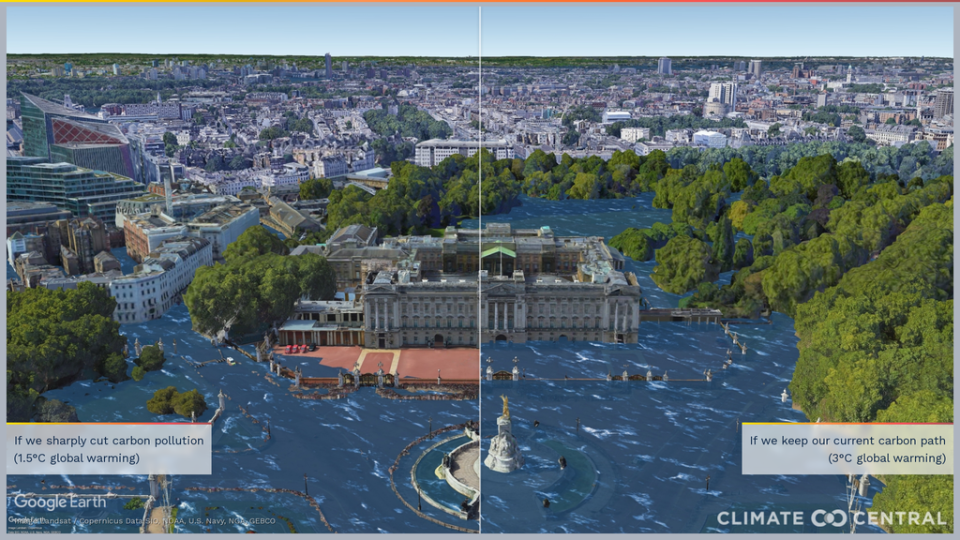Buckingham Palace among landmarks at risk from sea level rise without climate action, map shows
Buckingham Palace is one of many world landmarks at risk of succumbing to sea level rise if countries do not take urgent action to cut back on emissions and build stronger flood defences, a new study suggests.
Using high-resolution projections, the research warns that London, Glasgow and Bristol are among cities across the world facing “unprecedented” threats from sea level rise over timescales of decades to centuries as a result of the climate crisis.
If global temperatures reach 4C above pre-industrial levels, sea level rise could threaten land supporting up to 1 billion people over the coming centuries, the research finds.
However, meeting the Paris Agreement’s goal of keeping global temperatures below 2C could save hundreds of millions of people from the risks posed by rising seas, it adds.
Large coastal cities in Asia and small islands such as the Bahamas, the Maldives and Kiribati face particularly large threats from long-term sea level rise.
The findings come just weeks before the Cop26 climate summit in Glasgow, where world leaders will try to forge a path to get on track to meeting the targets of the Paris Agreement.
Study lead author Dr Ben Strauss, CEO and chief scientist at Climate Central, said the findings illustrated how the actions agreed at the meeting will affect life on Earth for hundreds of years to come.
“To me the main message is how great the difference is between our possible future worlds depending on whether we cut pollution sharply or continue closer to business as usual,” he told The Independent.
“Our descendants are going to be dealing with these consequences for hundreds of years. It’s about the survival of scores of coastal cities around the world.”
The study, published in the journal Environmental Research Letters, is the first to project how long-term or “multi-century” sea level rise could impact every part of the globe in the years ahead.
The research examines sea level rise over a range of possible futures, ranging from one where countries successfully limit temperatures to 1.5C to scenarios where the world experiences 3 or 4C of global heating.
How much of a temperature rise the world is likely to experience largely hinges on actions in the near future, science shows.
For example, to have a fair chance of limiting global temperatures to 1.5C, global emissions will need to fall by 45 per cent by 2030, when compared to levels in 2010, according to a recent landmark climate assessment. (Global emissions are currently expected to increase by 16 per cent by 2030.)
However, the research illustrates how failing to meet climate targets in the coming decades could have repercussions for hundreds of years.
This is because sea levels are expected to rise over timescales of several centuries as a result of ocean heating, which causes water to expand, and the melting of glaciers and ice sheets.
The new research estimates that, if global temperatures reach 3C, Buckingham Palace could be flooded up to the second floor as a result of sea level rise at some point over the coming centuries. If temperatures are kept at 1.5C, waters are likely to instead reach the palace door.

Other landmarks particularly threatened by sea level rise include The Pentagon in Washington DC, Tokyo Tower in Japan and the Tower of London.
All of the findings rely on the assumption that no new defences are put in place to deal with sea-level rise.
Dr Strauss said that it should be expected that countries will bring in new measures to deal with rising risks. However, if little is done to tackle rising emissions, rising sea levels will become increasingly difficult to adapt to in many regions, he added.
Dr Ella Gilbert, a climate scientist at the University of Reading who was not involved in the study, said the findings “underline the importance of limiting warming as much as possible”.
“Sea-level rise presents a very real threat to people living all over the world, including in some of the most densely populated parts of the planet,” she told The Independent.
“The authors make a few assumptions, which could influence the results. First, they assume no negative emissions technologies are deployed, which could reverse some of that sea level rise over the very long-term.”
Negative emissions technologies is the term given to techniques that can remove CO2 from air, such as large-scale tree-planting or CO2-sucking machines.
“They also do not directly consider future coastal defences that would probably be built to protect these cities, which would also potentially minimise the impact,” she added.
“However, this doesn’t detract from the key message that climate change carries huge flood risks that will affect real people on every continent on Earth – and that we need to do everything we can to reduce these potentially devastating effects.”
Read More
World’s largest carbon-sucking factory starts operation in Iceland
‘The climate crisis is a reality’: Africa’s summer of extremes
Against the odds: The fight to save sea turtles in Ras Baridi

